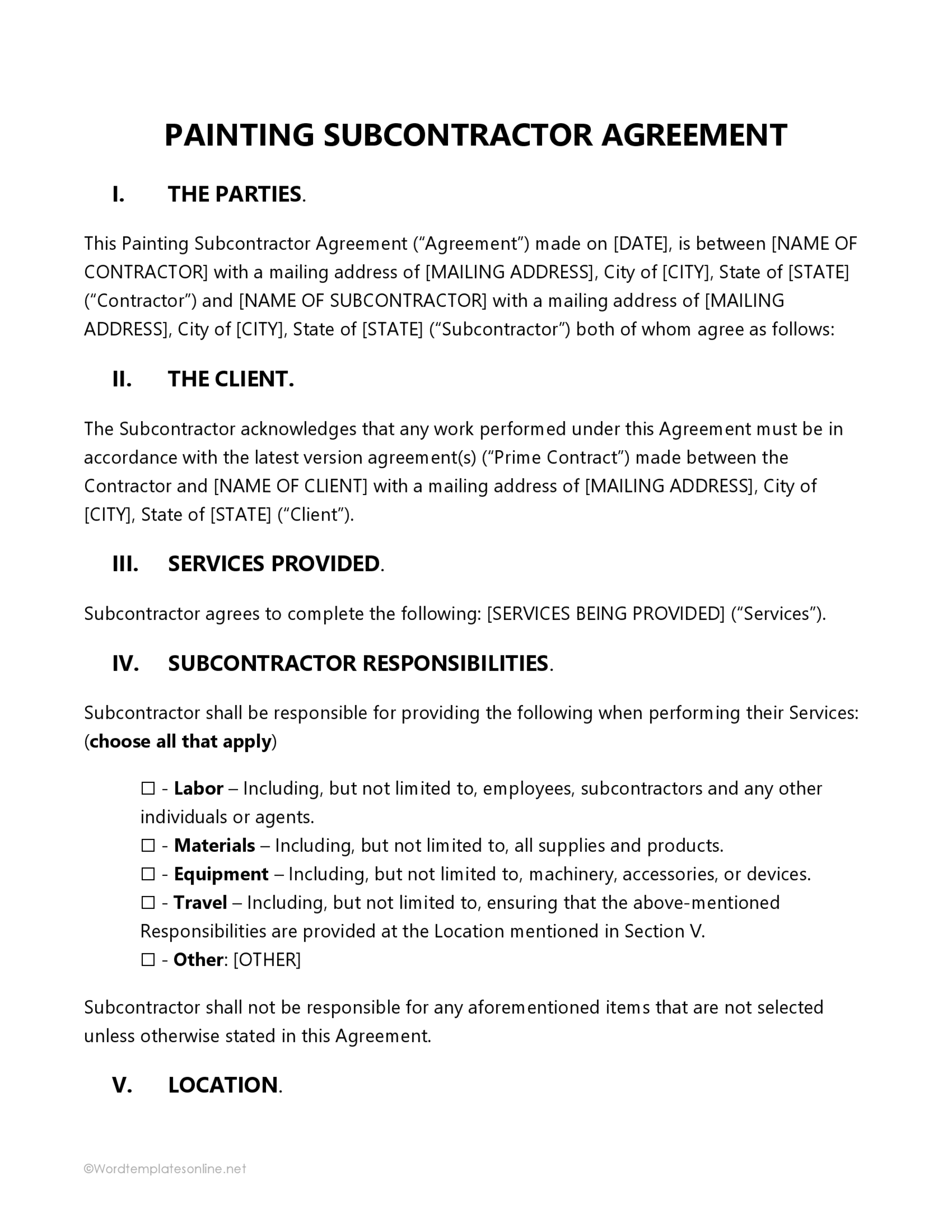As a contractor or business person, you must know how to utilize the skills and expertise offered by subcontractors. This is especially important when performing projects that require a wide range of specialized personnel. You can recruit different professionals to help complete various tasks efficiently. With proper delegation, you can set timelines within which each task should be completed, which in turn makes it easy to achieve the project’s goals.
When executing a project, you must hire subcontractors to help in areas requiring special skills or resources. Hiring experts allows you to outsource critical skills, maintain work quality, and deliver the project within the required timelines. You can assign tasks fairly and according to each member’s expertise, which promotes the delivery of quality products or services while ensuring the workload is fairly spread out.
This article provides information on what a template for a sub-contractor agreement should have and the types you can use. It also offers tips and tricks on preparing an effective document. There are free templates provided in MS Word format you can edit and customize for your use.
Free Templates












What is a Subcontractor Agreement Template?
A subcontractor agreement template is a formal document that sets out the conditions of engagement between you and a subcontractor.
This is a legally binding contract that contains sections outlining the services to be provided, governing law, and the responsibilities of each party. It helps to create a standardized and consistent structure for your agreements, which promotes fairness and professionalism in your collaborations with subcontractors.
When you use a template, you can create a uniform framework that helps you maintain consistency and clarity in your contracts. You can mention obligations between different parties in different contracts with a good template. Further, you can refer to it when presenting proposals to your business partners.
Elements of a Subcontractor Agreement Template
Your agreement should provide sufficient information about the service or task you are subcontracting. These details include terms of service, payment, and the type of work to be done. Having a well-written document makes it easier to engage with your business partners.
As such, the following elements are crucial and must be included in your template:
Parties
The parties to the agreement, usually the contractor and subcontractor, must be stated clearly in this first part. You should indicate your and the subcontractor’s names and obligations. Additionally, you must include the contact information, including telephone numbers, email, and physical addresses. This section helps you verify the identity and authenticity of the subcontractor.
Work and services provided
This section defines the scope of work to be done by the subcontractor. It often includes the duties, tasks, and responsibilities they are expected to fulfill. The tasks should be outlined as clearly as possible; this helps avoid confusion and streamline the contract-making process.
Terms and conditions
The agreement must lay out the terms and conditions under which the parties will perform their obligations. This section of your agreement often contains the set standards and quality of work expected of the subcontractor. It is the crucial part of the agreement that mentions the prescribed methods of communication and other terms that define the relationship between you and the subcontractor. It also defines other specific terms like the time of operation, the laws and regulations to be complied with, and the rights of ownership of the project. It should help the parties understand the project better and the scope of their duties.
Compensation details
On the other hand, the subcontractor should know how much they will be paid for the work done. Compensation should include the payment rate and whether the subcontractor will be paid a salary or receive hourly work payments. This section is vital because the tasks to be performed often vary in complexity and mode of delivery. The compensation should also cover the rates used in case of emergencies or sudden changes to the project’s performance.
Payment schedule
You should outline how the subcontractor will be paid. You can indicate whether you will pay upon the achievement of particular milestones or deliverables. It allows you to clearly communicate with the subcontractor when to expect payment, which creates transparency in your dealings.
Deadlines and milestones
Since most projects are time-based, it is vital to ensure the project’s expected milestones are mentioned clearly. This section may be tabulated or written as a list for easier understanding. All the deadlines should be indicated as accurately as possible; if, for example, you are to achieve a deadline within a particular period, the agreement should indicate the timeline. Deadlines act as reminders to help track everyone’s progress with their tasks. This promotes accountability and adherence to the timelines agreed upon by both parties.
Warranty
Warranties vary according to the services being provided or tasks being performed. They speak to the quality and standards of the project’s outcome. If there are any expectations and guarantees the subcontractor promised to provide, then they should be indicated in this section. These expectations help parties understand the quality of work expected of them; they also guarantee that there will be compensation should the work not be up to standard.
Indemnity and insurance
Insurance protects you from total loss should the project not be successful. Indemnity, conversely, guarantees that the subcontractor shall pay for any claims or issues arising from their work. This section should clearly state the reasons or circumstances under which indemnification should happen. Additionally, if any insurance obligations are to be undertaken as part of the contract, you should include them here.
Relationship between parties
There is often a difference between an employee and an independent contractor, which should be defined here. This distinction helps you remain compliant as each category has legal and tax implications, and it should be clear to help you define the type of working relationship. You should indicate that the subcontractor is an independent entity, only contracted to perform a specific task following the contract terms.
Exclusivity
Some subcontractors may want to take other jobs while they are simultaneously contacted to perform tasks in your project. The contract should indicate whether the subcontractor can work with other clients while undertaking your projects, as in some cases, this may bring conflict and strain the relationship between the parties. The exclusivity section lets parties agree on whether the subcontractor will work exclusively for you.
Termination
This part of the contract should outline the reasons either party can terminate the contract. It should also indicate the consequences of termination, whether there will be a fine or penalty because of the termination. Termination should also include the timelines for notification and the procedure to be followed.
Dispute resolution
Like any other contract, this agreement should have a dispute resolution clause. This provides mechanisms for resolving any issue that might arise between the parties. The different methods include negotiation, mediation, arbitration, and litigation. The clause may discuss the use of alternative dispute resolution methods before using litigation. For example, the parties may agree to negotiate or mediate any issue before taking legal action.
Governing law
The governing law is often the law of the jurisdiction in which the agreement is to be made. The template should state that the law to be used will be that of the state in which the contract is made or that of the project’s location.
Confidentiality and non-disclosure
Subcontractor agreements often contain confidential information that should not be shared with third parties who are not involved in the contract. The confidentiality clause should define the scope of what is considered private information. This allows the parties to feel free to share sensitive details that can help make the project successful without fear of being exposed.
Severability
The severability clause allows the contract to remain operational even where other clauses are found to be unenforceable. Include this clause to help the subcontractor understand that if some part of the contract is declared invalid, the rest of the agreement remains valid.
Entire agreement
You should indicate that the agreement, as a whole, portrays the parties’ understanding. This ensures that there is no confusion based on other negotiations, verbal agreements, or previous contracts between the parties. This part also guarantees the parties that other documents shall not apply to the terms in the current agreements.
Amendments
Should there be the need to make changes to the agreement, you should have a clause that provides how to execute the changes. This clause should also state the communication procedure and the amendments’ period. Using clear procedures promotes professional engagement and modification of amendments that make communication and transparency more efficient during collaborations.
Signature and date
At the end of the agreement, there should be a place for both parties to sign and indicate the date. The signature shows that the parties are in agreement and understand their obligations. It is crucial to mark the dates on the contract for record purposes, especially where the contract is to operate within a stipulated timeline.
Tips for Crafting Your Subcontractor Agreement Template
You can download and use any subcontractor template from the internet; however, to ensure it is effective, you have to customize it to suit your needs. The following tips and tricks can help you create an excellent agreement:
- Use headings and sections to help the reader understand what each part of the template contains. With well-outlined sections, you can promote the visibility of the entire agreement, making it look neat and organized. Also, ensure each heading is specific to one section or topic, for example, parties, scope of work, compensation, and governing law.
- Your template should provide only the basic terms of any contract; this allows you to customize it to any agreement in a different field of work. You can then include specific sections that can be customized to particular elements of any project; this helps you save time when creating a new contract.
- Over time, the contract and its requirements might change, so update your template regularly to ensure you remain compliant. Updating your template frequently allows you to maintain the standard form while being efficient in the contract-making process.
- The contract is a formal document, as such, you should maintain professionalism at all points when drafting. This includes using a formal tone in the agreement, language, and even the salutations.
- Since contracts vary in length, it is advisable to have user-friendly formatting. Use uniform fonts, spacing, and formatting to ensure the document looks organized. An organized document helps the reader understand the content of the contract.
Types of Subcontractor Agreement Templates
Since different types of services and tasks need to be completed to complete a project, it is necessary to understand the different types of templates you may need.
They vary across other sectors and include:
Construction subcontractor agreement template
This is an agreement between a general contractor and a subcontractor for construction services. The contract often defines the specific part of a construction project the subcontractor is expected to undertake.
Professional services subcontractor agreement template
Like other agreements, this is made between a contractor and a subcontractor who undertakes to provide a specific service for a limited period in exchange for compensation. The contract is usually based on expertise, educational qualifications, or technical abilities.
Business associate subcontractor agreement template
This is an agreement between a company or covered entity and an entity dealing with protected health information. This document is necessary for organizations or associations that have contracted the services of a business associate. It defines the scope of the work and stipulates the degree of confidentiality of the information the associate is handling and disclosing.
Painting subcontractor agreement template
A painting subcontractor agreement is made between a person or company and a contractor seeking painting work for a larger project. The terms of the contract have to include the scope of work, the compensation, and the expected hours of work for each painter. These agreements can be used when hiring contractors for internal, external, residential, or commercial painting projects.
Cleaning subcontractor agreement template
Hygiene and cleanliness are vital to any workplace, site, or building, hence the need for a cleaning contract. This agreement is made between cleaning companies, individuals, and contractors to provide cleaning services. The terms often include working hours, uniform policies, and the person in charge/management of the cleaning crew.
Truck driver subcontractor agreement template
As the title says, contractors can hire truck drivers to move goods from one location to another by preparing subcontractor agreements. In this case, the truck driver is the subcontractor. The contract should define how payment will be made and by whom. It should also stipulate whether the contractor will provide the trucks, which is the most common method.
Electrical subcontractor agreement template
These agreements are commonly used for contracting wiring services for construction projects. The parties agree on the expected quality of work, the type of material to be used, and the insurance to be maintained, if any.
Roofing subcontractor agreement template
Roofing is one of the final stages of completing construction projects. These tasks can be contracted to a roofing expert or company. The template should describe the expected quality, warranty, guarantee, and the parties covering material expenses.
Conclusion
It is essential to understand the type of skill you need for every part of a project. For successful completion, you may have to outsource individuals from different sectors. This is where subcontractor agreements are helpful. It is easier to build these agreements when you have a template that contains a guide and all the essential information in terms of engagement.
Besides saving time, a good template allows you to focus more on the technical aspects of the contract, such as the scope of work. You can create a comprehensive document and customize it to your needs whenever you need to prepare an agreement. Therefore, you should prepare a template for a subcontractor agreement for the different sectors involved in any project you want to undertake.









